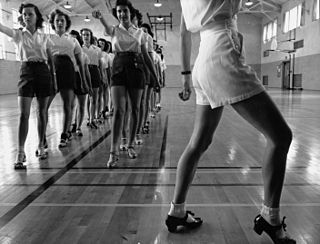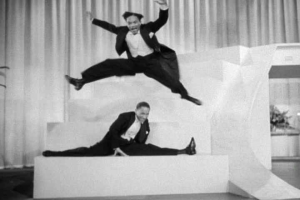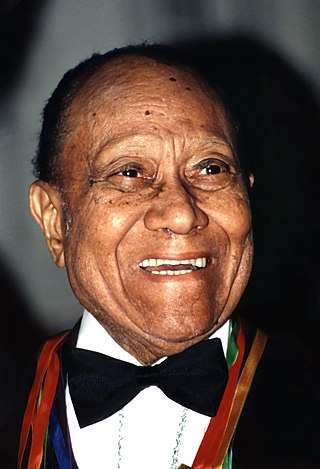
Tap dance is a form of dance characterized by using the sounds of tap shoes striking the floor as a form of percussion. Two major variations on tap dance exist: rhythm (jazz) tap and Broadway tap. Broadway tap focuses on dance; it is widely performed in musical theater. Rhythm tap focuses on musicality, and practitioners consider themselves to be a part of the jazz tradition.
Dance moves or dance steps are usually isolated, defined, and organized so that beginning dancers can learn and use them independently of each other. However, more complex movements are influenced by musicality and lyrical relevance to express emotions or refer to a message. Dance moves tend to emphasize the concepts of lead and follow and connection.

The Shim Sham Shimmy,Shim Sham or just Sham originally is a particular tap dance routine and is regarded as tap dance's national anthem. For today's swing dancers, it is a line dance.

Country–western dance encompasses any of the dance forms or styles which are typically danced to country-western music, and which are stylistically associated with American country and/or western traditions. Many are descended from dances brought to the United States by immigrants from the United Kingdom and Europe as early as the 1700s, which became integrated into American popular culture. Country dancing is also known as "kicker dancing" in Texas.

Bill Robinson, nicknamed Bojangles, was an American tap dancer, actor, and singer, the best known and the most highly paid African-American entertainer in the United States during the first half of the 20th century. His long career mirrored changes in American entertainment tastes and technology. His career began in the age of minstrel shows and moved to vaudeville, Broadway theatre, the recording industry, Hollywood films, radio, and television.

The Nicholas Brothers were an entertainment act composed of brothers, Fayard (1914–2006) and Harold (1921–2000), who excelled in a variety of dance techniques, primarily between the 1930s and 1950s. Best known for their unique interpretation of a highly acrobatic technique known as "flash dancing", they were also considered by many to be the greatest tap dancers of their day, if not all time. Their virtuoso performance in the musical number "Jumpin' Jive" featured in the 1943 movie Stormy Weather has been praised as one of the greatest dance routines ever captured on film.

Fayard Antonio Nicholas was an American choreographer, dancer and actor. He and his younger brother Harold Nicholas made up the Nicholas Brothers tap dance duo, who starred in the MGM musicals An All-Colored Vaudeville Show (1935), Stormy Weather (1943), The Pirate (1948), and Hard Four (2007). The Nicholas brothers also starred in the 20th Century-Fox musicals Down Argentine Way (1940), Sun Valley Serenade (1941), and Orchestra Wives (1942).

Harold Lloyd Nicholas was an American dancer specializing in tap. Nicholas was the younger half of the tap-dancing pair the Nicholas Brothers, known as two of the world's greatest dancers. His older brother was Fayard Nicholas. Nicholas was featured in such musicals as An All-Colored Vaudeville Show (1935), Stormy Weather (1943), The Pirate (1948), and The Five Heartbeats (1991).
Clogging is a type of folk dance practised in the United States, in which the dancer's footwear is used percussively by striking the heel, the toe, or both against a floor or each other to create audible rhythms, usually to the downbeat with the heel keeping the rhythm.
The Melbourne shuffle is a rave dance that developed in the 1980s. Typically performed to electronic music, the dance originated in the Melbourne rave scene and was popular in the late 1980s and 1990s. The dance moves involve a fast heel-and-toe movement or T-step, combined with a variation of the running man coupled with a matching arm action. The dance is improvised and involves "repeatedly shuffling your feet inwards, then outwards, while thrusting your arms up and down, or side to side, in time with the beat". Other moves can be incorporated including 360-degree spins and jumps and slides. Popular Melbourne clubs during the dance's heyday included Hard Kandy, Bubble, Xpress at Chasers, Heat, Mercury Lounge, Viper, Two Tribes at Chasers and PHD. Melbourne's first techno dance parties Biology, Hardware and Every Picture Tells A Story were popular with Melbourne Shuffle innovators.
Shuffling is a procedure used to randomize a deck of playing cards.
Footwork refers to dance technique aspects related to feet: foot position and foot action.
The Four Step Brothers were an American dance group. The group started out as a trio in 1925, with the original members, Maceo Anderson, Al Williams and Red Walker. Although their original name was the Step Brothers, because that was also the name of another famous young tap dancing quartet, they subsequently changed their name to "The Three Step Brothers." In 1927, after accepting a new member, Sherman Robinson, they became The Four Step Brothers. Dubbed "The Eight Feet of Rhythm," the group soon traveled with Duke Ellington. While starring with the "Brothers," Anderson also appeared at the Hoofers Club and worked part-time as a newsboy.
Tap dance makes frequent use of syncopation. Tap dance choreographies typically start on the eighth beat, or between the eighth and the first count.
Flash dancing was a form of tap dance that evolved in the 1920s–1930s, which combined dance with acrobatics. Prominent flash dance acts of the time include the Nicholas Brothers, The Four Step Brothers and the Berry Brothers.

LaVaughn Robinson was an American tap dancer, choreographer, and teacher.
Bachata is a style of social dance from the Dominican Republic which is now danced all over the world. It is connected with bachata music.
Kahnotation is a tap dance notation developed by Stanley D. Kahn to document and communicate tap dancing steps and routines.
Tip, Tap, and Toe were a seminal African-American tap-dance comedy act that began in the late 1920s and appeared in several motion pictures in the 1930s and '40s. Its original members were Sammy Green, Teddy Frazier, and Raymond Winfield. At times it included Freddie James and Prince Spencer, also a member of The Four Step Brothers. They worked for Eddie Cantor at Palace Theatre in New York and performed on their own at the Paramount Theatre, and were in George White's Scandals of 1936 and the Cotton Club Review. African-Americans were not allowed to star in major motion pictures in the 1930s and '40s, but specialty acts, such as Tip, Tap, and Toe, were permitted, and the group appeared in at least five major Hollywood films during that time.







